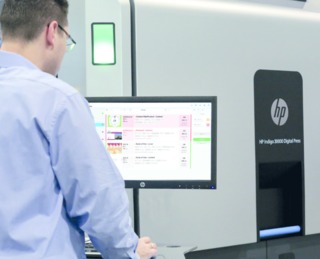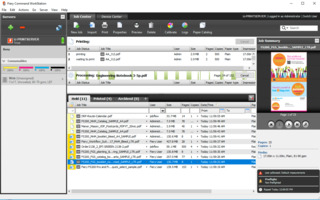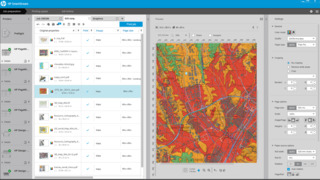DFEs: Feeding the Need for Speed on Press
How digital front ends are continuing to optimize inkjet printing.

Last fall at Graph Expo 2016, if you dropped by the Printerverse’s Case Study Café, a panel comprising a book author, printer, publisher, and printing equipment vendor discussed a unique project that may point to the future of book printing and publishing.
The book was titled Unsquaring the Wheel, an educational title written by Chris Bondy, Wayne Peterson, and Dr. Joe Webb, designed to help print businesses redefine themselves for a new generation. The book was produced using HP’s new One Book workflow, and also included augmented reality (AR) features: the cover and interior pages featured digital watermarks that, when scanned by a smartphone running HP’s Link app, accesses personalized content as well as Internet links videos, and other supplementary material. (Editor’s note: For more on AR, see pg xx in this issue.)
Even without the AR content, book printing today can be a complicated production process. For example, a book manufacturer can receive orders from many different channels—from Ingram, Amazon, individual publishers, and so on. These orders can be for books of different sizes and different attributes, such as perfect bound vs. casebound vs. stitched, use different substrates, and so forth.
“Say I have 10,000 orders coming in a day,” says Bob Raus, category manager, Workflow and Partner Programs at Hewlett-Packard. “Each one is one book. They’re different sizes, different bindings, and shipped to different addresses. How do you manage something like that?”
At the same time, once a book block is printed, it needs to go into finishing and be paired with the appropriate cover which may be printed on another device, such as an Indigo, elsewhere in the plant. Then it needs to be bound in the appropriate manner, have any additional materials – like a CD – attached, packed with any other titles going to the same destination, and then shipped.
This is part of what HP’s PrintOS Site Flow and One Book allow printers to do. All the individual elements are barcoded, and are all scanned at every stage throughout the production process to tell operators what pieces to marry up and what processes to perform. At the end of the entire workflow, the system can even contact FedEx or UPS and schedule shipping. “The whole idea is efficiency and tracking in a seemingly chaotic environment of all these different pieces,” says Raus. The PrintOS platform runs in the cloud, Raus says, “so there are no servers, no maintenance, and no capital investments. You pay as you go on a tiered model based on how any orders you’re processing.”
The cloud-based PrintOS platform may not immediately seem like it would fall into the category of “digital front end,” but as production inkjet printing takes on more and more products and applications, the “front end” need to evolve and grow so as to be able to solve specific tasks and serve specific needs.
Adding layers and functionality
What exactly do we mean by “digital front end?”
“The DFE is basically the RIP plus other workflow capabilities that are integrated into it,” says Mike Robinson, senior product line manager for EFI Fiery. “The DFE is more than just what the RIP has been in the past, which was a simple raster processor. Now, the DFE encompasses more features than that and reaches into the prepress part of the workflow, as well as MIS or ERP.”
When it comes to thinking about DFEs for inkjet, says Marc Johnson, marketing manager for Commercial PageWide Industrial at HP, “you’ve got layers. One layer is the thing that runs the press, which you size and scale so you’re not starving the press, you’re always feeding it a constant stream of data.”
“You have the MIS up front, prepress plus the DFE, then the press, then there’s finishing,” says Robinson. “That’s the workflow.”
Additional layers add different functionality, depending upon what applications the press was acquired to produce. “Certain applications really lend themselves to specific things in the DFE, others not so much,” says Robinson. “Transactional requires a streaming approach, and the ability to manage a whole lot of data that needs to be processed at speed. There is specialized horsepower that is needed in the DFE to make that work.”
These additional layers can be provided by third-party partners of hardware and software vendors, such as GMC, XMPie, and many others.
Feed the press
Regardless of what functionality is needed for specific tasks – books, transactional, direct mail, etc. – the DFE has one basic job that supersedes all others: feed the press. So a good DFE will have the horsepower required. “The goal of the DFE is to make sure the press is going at its full-speed,” says Robinson. Other tasks may also fall to the DFE.
“On a lot of presses, color management has to happen in the DFE, as there are no plates,” says Robinson. “They rely on the DFE to make color management work.”
This also gets us back to the changing nature of book printing. “You have this terrific print engine, and now the question is, how do you keep it busy?” said Raus. “The idea that we’re going to print 5,000 books or 100,000 newsletters is outdated. It happens, but we’re seeing book orders down to quantity of one.” Ergo, it falls on the DFE to be able to keep up with the part of the workflow that is producing those book blocks.
“A good DFE is something is going to be very powerful and have a lot of options for being able to plug and play into different parts of the workflow,” says Robinson. “There are many different ways that you can hook up your systems to a DFE – and that will change.”
The nature of the print marketplace today means that the applications and products that are in demand are constantly changing. Production inkjet machines are flexible enough that they can handle new applications. The goal is to ensure that the software driving the print engine can keep up. “We want the DFE to be flexible,” says Robinson. “You need to make sure you have something that will adapt as your customers’ needs are changing."
Marriages of convenience
As printers acquire digital presses, specifically inkjet presses, they need to know that they are not being thrown to the wolves when it comes to choosing the best front end for the specific press. The manufacturer or dealer can and should provide sage advice and recommendations based upon the specific applications and products the press is being acquired to produce. After all, it’s imperative that the DFE be as closely “bonded” with the press as possible.
“You want a very tight integration between the DFE and the actual press to manage the data, throughput, and image quality,” says Robinson. “Some presses even give you the ability to automatically check output for errors inline and in that case you want the DFE to be able to use that feedback immediately.
“The optimal DFE is designed to maximize the possibilities of the press.”
The DFE Decision Process
If you want to acquire or upgrade a digital press, it’s a good time to evaluate your DFE selection process. What approach did you take in your last DFE decision? Should you now consider a different approach in order to take advantage of new capabilities the can benefit your business?
In its discussion with digital printing firms, EFI found that decision makers took a variety of approaches, including:
* Purchasing made the DFE decision with little or no input from production: This seems to occur most often in in-plant operations and larger organizations where cost, existing contractual arrangements, or previous decisions take precedence in determining the final configuration of the press. This is not an optimal approach since it negates the day-to-day knowledge and skills of the production operation, and can leave them with a suboptimal solution. While this approach may deliver a lower up-front cost, it can often have repercussions on the total cost of ownership if production professionals do not have the right tools to work with.
* Buying criteria for a DFE was based only on the current mix of jobs: The jobs being produced today may not be complex and/or the current staff has minimal skills. There is no perceived need to add cost with DFE capabilities that may never be used. This approach can also have negative longer-term ramifications. Printing businesses running a limited job set that is truly not complex today, and configure their presses accordingly, run the risk that they will encounter future competitive forces that require a broader product capability and higher productivity. Not having this flexibility could compromise a company’s profitability over the course of the lease.
* Quickly accepting the press manufacturer sales rep’s recommendations: Sales reps eager to close a press sale may not fully present the multiple DFE options offered with the target press. They may encourage the buyer to quickly proceed with the DFE from the press manufacturer. In this case, buyers should avail themselves of the opportunity to research all available options in order to be better educated as they proceed through the sales process. They should be aware of the pros, cons, and capabilities of each DFE that’s offered with the press they want. It’s important for print businesses to understand how each will fit into a specific workflow and process particular applications, and consider how each can best be integrated into the overall workflow. And it is critical to test files to ensure the true performance of the DFE.
* “We’ve always done it that way”: In this case, the organization has been using digital presses with a specific DFE for some time. Management has no desire to change or to even investigate improvements to DFE speed and technology and how enhancements could benefit their operation. The barriers to change might be staff skill levels, the time required for training, and/or the level of automation achieved with the existing DFE. There may be concerns that changing the DFE will consume significant IT resources in order to ensure appropriate integration into existing systems. In this case, decision makers should at least examine the options in order to determine if all or some of their other systems and modules can be replaced by the capabilities of a more advanced DFE. Many owners who have developed homegrown systems because there were no adequate solutions in the market to meet their needs, are now realizing they really don’t want to be in the software-development business. If this is your situation, it may be time to take a fresh look at what’s now available in DFEs.
* Investigating the right DFEs to find the right fit: The staff is extremely knowledgeable about its digital presses and DFEs, and enters into the decision process fully informed and with files in hand, ready to test. This, of course, is the ideal situation. In this scenario, the outcome of the decision is more likely to be a total solution that will lend itself to growth and profitability over time.
In any of these scenarios, doing your homework with an open mind will yield benefits. This can be as simple as reading literature online, or as thorough as the ideal option of attending demonstrations where you can personally test your routine and complex files against the available options.
– From the EFI white paper, “Choosing the Right Digital Front End”


